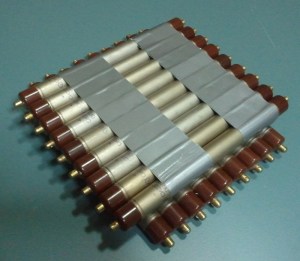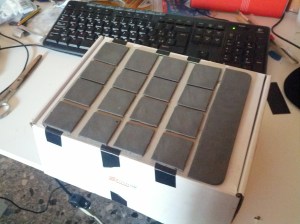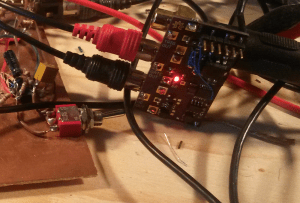
This week’s Hacklet is all about Hackaday.io projects which use MIDI, or Musical Instrument Digital Interface for the uninitiated. MIDI was designed from the ground up as an open communications standard for musical instruments. Nearly every major instrument company participated in the design of the standard. MIDI was first demonstrated in January of 1983, with the communications standard document following in August. Hackers, makers, and musicians immediately ran with it, using MIDI to do things the designers never dreamed of.
 [Robert’s] 9×9 Pixel Muon Detector/Hodoscope is a great example of this. [Robert] is using 18 Geiger Muller Tubes to detect cosmic particles, specifically muons. The tubes are stacked in two rows which allows him to use coincidence detection. Rather than just plot some graphs or calculate impact probabilities, [Robert] hacked a Korg Nanokey 2 MIDI controller to output MIDI over USB messages corresponding to the detected muons. Check out his video to see a sample of the music of the universe!
[Robert’s] 9×9 Pixel Muon Detector/Hodoscope is a great example of this. [Robert] is using 18 Geiger Muller Tubes to detect cosmic particles, specifically muons. The tubes are stacked in two rows which allows him to use coincidence detection. Rather than just plot some graphs or calculate impact probabilities, [Robert] hacked a Korg Nanokey 2 MIDI controller to output MIDI over USB messages corresponding to the detected muons. Check out his video to see a sample of the music of the universe!
 Next up is [Michele’s] DIY MPC style MIDI controller. [Michele] needed a simple low-cost drum controller that wouldn’t wake his neighbors. He loved Akai MPC controllers, so he rolled his own. [Michele] investigated force sensitive resistors but found they were very expensive. At a cost of $8 USD each, his resistors alone would be nearly the cost of a low-end MPC! [Michele] created his own sensitive pads using a sandwich of copper tape and 3M Velostat conductive sheets. An HCF4067 routes all the analog lines to a single pin of Teensy 3.0, which then converts the analog resistor outputs to MIDI messages.
Next up is [Michele’s] DIY MPC style MIDI controller. [Michele] needed a simple low-cost drum controller that wouldn’t wake his neighbors. He loved Akai MPC controllers, so he rolled his own. [Michele] investigated force sensitive resistors but found they were very expensive. At a cost of $8 USD each, his resistors alone would be nearly the cost of a low-end MPC! [Michele] created his own sensitive pads using a sandwich of copper tape and 3M Velostat conductive sheets. An HCF4067 routes all the analog lines to a single pin of Teensy 3.0, which then converts the analog resistor outputs to MIDI messages.
 [Johan] loves his analog synths, and wanted them to be able to talk MIDI too. He built MIDI2VC, a circuit which converts MIDI to 1V/Octave (similar to CV/Gate). 1V/Octave is an analog control system used in some early synthesizers, as well as many modern analog creations. Pitches are assigned voltages, and as the name implies, each octave is 1 volt. A4 on the keyboard is represented by 4 volts, while A5 is 5 volts. [Johan] used a Microchip PIC16LF1823 to receive and convert the MIDI signals. The PIC outputs I2C data to an MCP4725 DAC which drives the analog side of the house.
[Johan] loves his analog synths, and wanted them to be able to talk MIDI too. He built MIDI2VC, a circuit which converts MIDI to 1V/Octave (similar to CV/Gate). 1V/Octave is an analog control system used in some early synthesizers, as well as many modern analog creations. Pitches are assigned voltages, and as the name implies, each octave is 1 volt. A4 on the keyboard is represented by 4 volts, while A5 is 5 volts. [Johan] used a Microchip PIC16LF1823 to receive and convert the MIDI signals. The PIC outputs I2C data to an MCP4725 DAC which drives the analog side of the house.
 Long before DMX512 came on the scene, hackers were controlling lights via MIDI. [Artis] continues this with El Dance, a wireless system for controlling electroluminescent wire worn by dancers. Similar in function to [Akiba’s] EL wire system, [Artis] took a lower cost route and used the venerable NRF24L01 radio module. He added an antenna which gives the modules a range of about 30 meters. The computer running the dance routine’s music sees the transmitter side of the link as a MIDI instrument. Standard note on and off commands activate the EL wire strings.
Long before DMX512 came on the scene, hackers were controlling lights via MIDI. [Artis] continues this with El Dance, a wireless system for controlling electroluminescent wire worn by dancers. Similar in function to [Akiba’s] EL wire system, [Artis] took a lower cost route and used the venerable NRF24L01 radio module. He added an antenna which gives the modules a range of about 30 meters. The computer running the dance routine’s music sees the transmitter side of the link as a MIDI instrument. Standard note on and off commands activate the EL wire strings.
 Our final hack comes from [Jen] who built a MIDI Vibrator Inductor Synth. [Jen] performs in an experimental music band called My Wife, with instruments as varied as violins and sewing machines. [Jen] must be a fan of Van Halen’s Poundcake as she’s using a similar technique, with a MIDI twist. An Arduino converts MIDI notes to analog values, which are sent to a motor controller board. The motor controller uses PWM to drive a vibrator motor at the frequency of the note being played. Like all DC motors, the vibrator puts out a ton of electromagnetic noise, which is easily picked up by [Jen’s] electric bass.
Our final hack comes from [Jen] who built a MIDI Vibrator Inductor Synth. [Jen] performs in an experimental music band called My Wife, with instruments as varied as violins and sewing machines. [Jen] must be a fan of Van Halen’s Poundcake as she’s using a similar technique, with a MIDI twist. An Arduino converts MIDI notes to analog values, which are sent to a motor controller board. The motor controller uses PWM to drive a vibrator motor at the frequency of the note being played. Like all DC motors, the vibrator puts out a ton of electromagnetic noise, which is easily picked up by [Jen’s] electric bass.
That’s it for this week’s Hacklet! Tune in next week for more projects from Hackday.io!
















My project didn’t make the zine : (
http://hackaday.io/project/192-PIC10F220-MIDI-Controller
Hey Greg – I wanted to use yours, but you didn’t have any images of the actual circuit. not to knock your diagrams, but I really like use images here on The Hacklet.
I should really get around to building this thing sometime. I have all the parts, just haven’t taken the time to wire it up!
It’s called a “hodoscope” not “holdoscope”. See: https://en.wikipedia.org/wiki/Hodoscope
When I first read that I thought it said Hodorscope!
hodor?
although it could have been clearer, my project also uses midi http://hackaday.io/project/1500-Kwese—musical-instrument
That last one should be tagged “Oh, My!”. I was thinking pager motor, until I clicked the video.
in my best George Takei voice: “ohh myyyyy”
I see muons then coming in groups frequently , why? Near the start I saw 9 and toward the end 15 or more .Is this an anomaly with the way recorded or does the size of the muons vary or the energy level perhaps ?
Its completely random and varies depending on the angle of entry and other scattering effects. The frame rate of the camera didn’t catch all, there are also a few technical compromises to give a visual display so a small percent will be triggered by terrestrial background sources. http://www.hardhack.org.au/detect_cosmic_ray http://www.hardhack.org.au/cosmic_rays_are
Bless the great creators and their wisdom to leave us NRPNs :) Seriously, one of the most wonderful protocols to ever touch my life. MIDI has provided me with laughs, my attempts at music (also laughs), taught me hex code msb lsb, even fed me through repairs and mods and recording sessions, soothed my mind in elevators and malls, and brought me the unwanted respect of the Florida industrial/goth crowd. You got me interfaced and learning with a computer, ya goose. I love some MIDI :).
It looks like the FSRs aren’t made by sandwiching the velostat between two contacts, can anyone explain to me how it’s working?
Hey there, first of all: WOW I’m on hackaday!
Secondly, the FSRs are actually made of two copper traces laid onto one layer of acetate sheet; the velostat is glued on the back of the pad surface and it’s a bit raised upon the traces. When a pad is pressed, the velostat closes the contacts between the traces; if you apply more pressure, more velostat will touch the traces, reducing overall impedence; moreover the velostat itself changes its impedence when under pressure, increasing the “velocity” effect of the sensor.